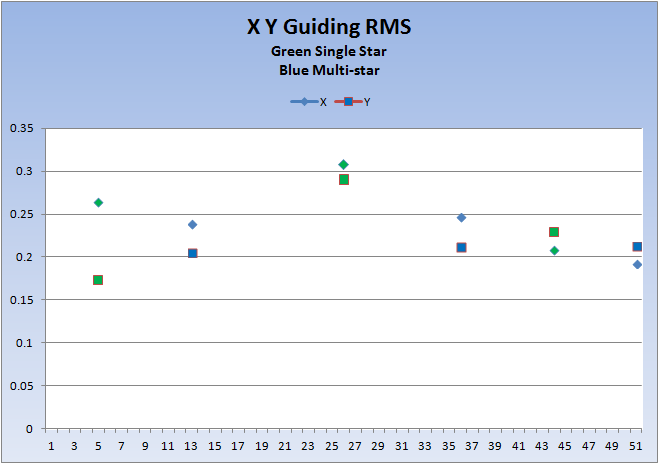I have always used single star guiding in Maxim. However, in Maxim version 6 they implemented multi-star guiding. I wanted to test the multi-star compared to the usual single star.
Basic conclusion: multi-star guiding does not show an appreciable gain in guiding precision. There may be other reasons for using it; perhaps it is more robust somehow, perhaps it is better in poor seeing conditions? I was unable to test these issues; I just looked at guiding precision.
The clear difference in guiding was better seeing as the night went on. The initial guiding started after astronomical twilight. Both guiding techniques improved significantly as the evening went on. I often see this trend when using the Subframe Selection script in PixInsight; as the evening wears on the FWHM moves steadily downward.
Data Collection
I imaged several 5 minute exposures, binned 2×2, using the Edge 11/STF8300M setup. The guider is the integrated STi in the 8300 package. This setup has an image scale of 0.80 arcseconds per pixel.The STi is binned 1×1. The same calibration settings were used for Single star and Multi-star guiding.
The images were well guided; I happened to have better seeing this night. In poorer seeing I typically see larger fluctuations in the guide errors. It may be that multi-star guiding would help more in poor seeing.
I used three targets: one in the Milky way to ensure a good number of guide stars for multi-star guiding, and two targets with few guide stars. The images are not calibrated or stacked, although the Maxim Filter tool was used to remove hot and cold pixels.
I measured the guiding accuracy using the graph tool in Maxim. After guiding has been started I clear the graph and let it run for 30-50 points. I then read the RMS X and Y errors from the graph, clear the graph, and repeat. In each situation (single or multi star guiding, a particular target) I repeat this process 5 times and average the results.
I also measured the FWHM of the resulting images using both CCDInspector and PixInsight. Their results were essentially the same, which is reassuring.
Results

This shows the RMS guiding error as the evening went on. The green points are using single star guiding, the blue use multi-star.
In the first half of the graph the RMS errors are more variable. In the second set of three readings the guiding has settled into a more consistent pattern.

These are the FWHM measurements from PixInsight (in pixels). The first image in particular was poorer (3.3 px * 0.8 as/px = 2.64 as. The last six images are around 2.4 arcseconds.
